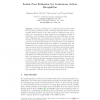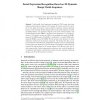100
Voted
ECCV
2008
Springer
16 years 2 months ago
2008
Springer
In this paper, we address the problem of 3D articulated multi-person tracking in busy street scenes from a moving, human-level observer. In order to handle the complexity of multi-...
118
click to vote
ECCV
2008
Springer
16 years 2 months ago
2008
Springer
The increased use of context for high level reasoning has been popular in recent works to increase recognition accuracy. In this paper, we consider an orthogonal application of con...
111
click to vote
ECCV
2008
Springer
16 years 2 months ago
2008
Springer
Abstract. We describe a new method for unsupervised structure learning of a hierarchical compositional model (HCM) for deformable objects. The learning is unsupervised in the sense...
132
click to vote
ECCV
2008
Springer
16 years 2 months ago
2008
Springer
Recently, models based on conditional random fields (CRF) have produced promising results on labeling sequential data in several scientific fields. However, in the vision task of c...
111
click to vote
ECCV
2008
Springer
16 years 2 months ago
2008
Springer
Abstract. Compressive sensing (CS) is an emerging field that provides a framework for image recovery using sub-Nyquist sampling rates. The CS theory shows that a signal can be reco...
117
Voted
ECCV
2008
Springer
16 years 2 months ago
2008
Springer
Visual tracking is a challenging problem, as an object may change its appearance due to viewpoint variations, illumination changes, and occlusion. Also, an object may leave the fie...
ECCV
2008
Springer
16 years 2 months ago
2008
Springer
129
click to vote
ECCV
2008
Springer
16 years 2 months ago
2008
Springer
Traditionally, facial expression recognition (FER) issues have been studied mostly based on modalities of 2D images, 2D videos, and 3D static models. In this paper, we propose a sp...
105
click to vote
ECCV
2008
Springer
16 years 2 months ago
2008
Springer
Abstract. Estimating a camera pose given a set of 3D-object and 2Dimage feature points is a well understood problem when correspondences are given. However, when such correspondenc...
107
click to vote
ECCV
2008
Springer
16 years 2 months ago
2008
Springer
In this paper, we address the problem of surface tracking in multiple camera environments and over time sequences. In order to fully track a surface undergoing significant deformat...


